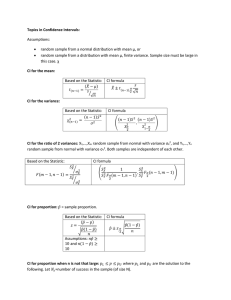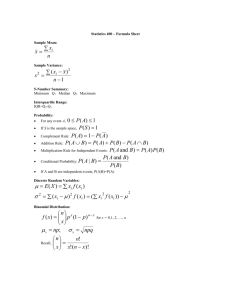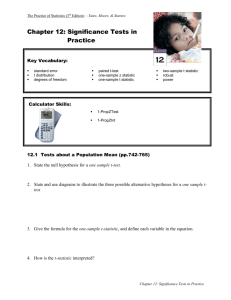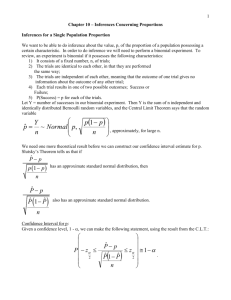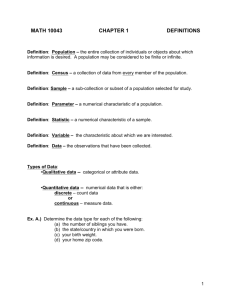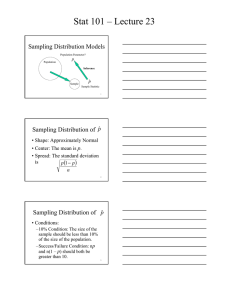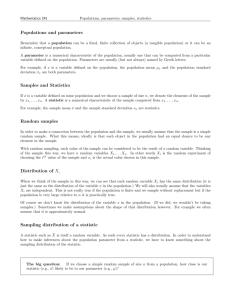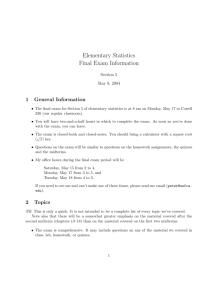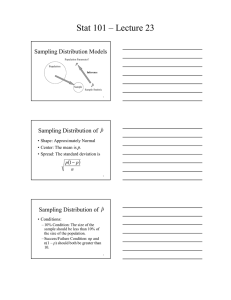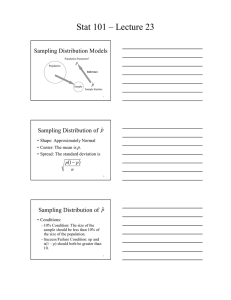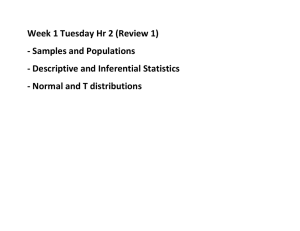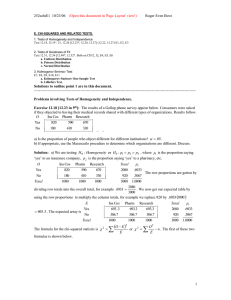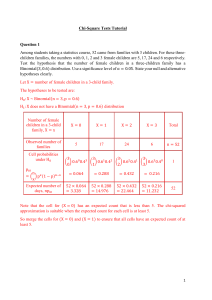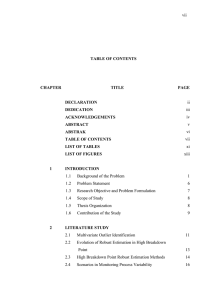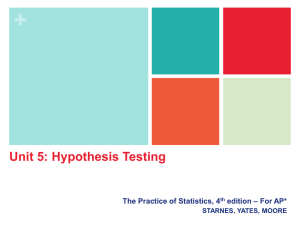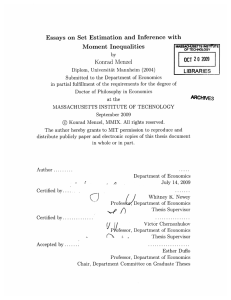Section 6.5 Inference Methods for Proportions
advertisement
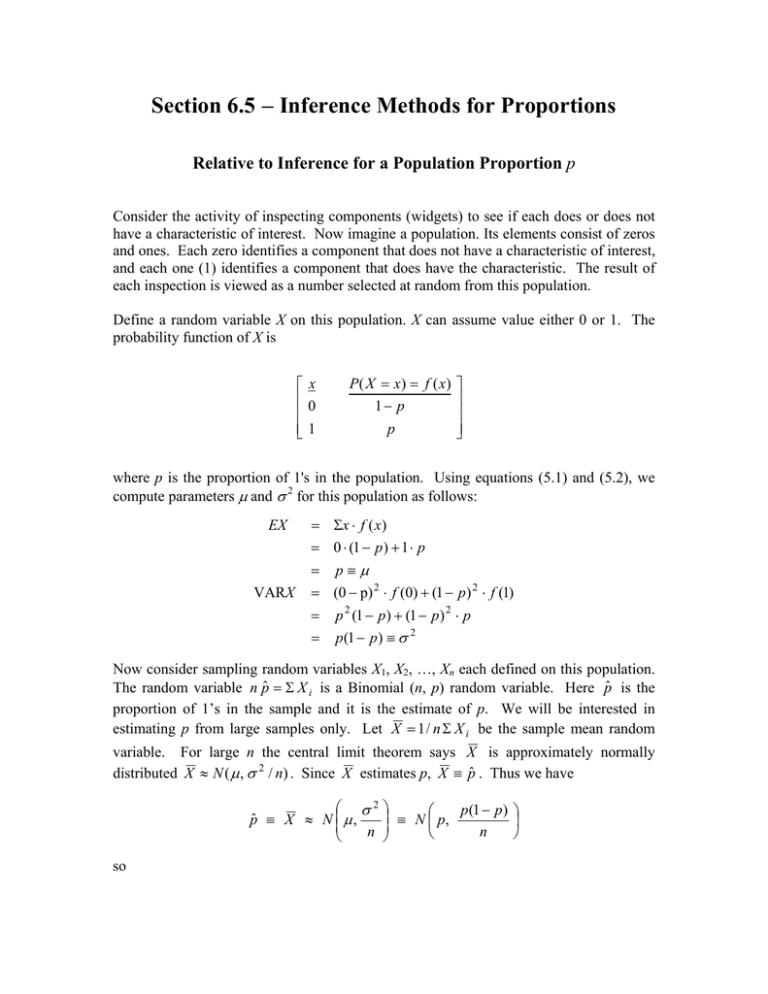
Section 6.5 − Inference Methods for Proportions Relative to Inference for a Population Proportion p Consider the activity of inspecting components (widgets) to see if each does or does not have a characteristic of interest. Now imagine a population. Its elements consist of zeros and ones. Each zero identifies a component that does not have a characteristic of interest, and each one (1) identifies a component that does have the characteristic. The result of each inspection is viewed as a number selected at random from this population. Define a random variable X on this population. X can assume value either 0 or 1. The probability function of X is x 0 1 P ( X = x) = f ( x) 1− p p where p is the proportion of 1's in the population. Using equations (5.1) and (5.2), we compute parameters µ and σ 2 for this population as follows: EX VARX = Σx ⋅ f ( x ) = 0 ⋅ (1 − p ) + 1 ⋅ p = p≡µ = (0 − p) 2 ⋅ f (0) + (1 − p ) 2 ⋅ f (1) = p 2 (1 − p ) + (1 − p) 2 ⋅ p = p(1 − p ) ≡ σ 2 Now consider sampling random variables X1, X2, …, Xn each defined on this population. The random variable n pˆ = Σ X i is a Binomial (n, p) random variable. Here p̂ is the proportion of 1’s in the sample and it is the estimate of p. We will be interested in estimating p from large samples only. Let X = 1 / n Σ X i be the sample mean random variable. For large n the central limit theorem says X is approximately normally distributed X ≈ N ( µ , σ 2 / n) . Since X estimates p, X ≡ pˆ . Thus we have σ2 pˆ ≡ X ≈ N µ , n so ≡ N p, p(1 − p) n Z = pˆ − p p (1 − p ) n ≈ N (0, 1) . Since we do not know σ this is not useful in practice. However when we use σˆ = pˆ (1 − pˆ ) then we have the practically useful (we are saying we know σ is σˆ ) Z = pˆ − p ≈ N (0, 1) . pˆ (1 − pˆ ) n (Recall we are assuming large n.) Using this result we can make inferences (confidence intervals and significance tests) about the parameter p using the random sample estimator pˆ = 1 / n Σ X i . SINGLE SAMPLE CASE For Large n (5 ≤ n p ≤ n − 5) Z = pˆ − p p (1 − p ) n ≈ N (0, 1) (1) and (using p̂ in place of p) Z = pˆ − p ≈ N (0, 1) pˆ (1 − pˆ ) n Using (2) an approximate 100(1 − α)% C.I. for p is pˆ (1 − pˆ ) . n pˆ ± zα / 2 To test: H 0 : p = # vs. H a : p ≠ # the test statistic is (using (1)) Z = pˆ − # # (1 − # ) n Examples 16 and 17 in Section 6.5 illustrates this. 2 (2) TWO SAMPLE CASE For Large n1 and n2 Z = pˆ 1 − pˆ 2 − ( p1 − p 2 ) p1 (1 − p1 ) p (1 − p 2 ) + 2 n1 n2 ≈ N (0, 1) (3) and Z = pˆ 1 − pˆ 2 − ( p1 − p 2 ) ≈ N (0, 1) pˆ 1 (1 − pˆ 1 ) pˆ 2 (1 − pˆ 2 ) + n1 n2 (4) using (4) a 100(1 − α)% C.I. for p1 – p2 is (its approximate) pˆ 1 (1 − pˆ 1 ) pˆ (1 − pˆ 2 ) + 2 n1 n2 pˆ 1 − pˆ 2 ± zα / 2 To Test: H 0 : p1 − p 2 = 0 vs. H a : p1 − p 2 ≠ 0 The test is (as always) based on assuming H0 true, i.e., p1 = p 2 ≡ p , so the test statistic is obtained by pooling the two samples to estimate the common value p as p̂ pˆ = n1 pˆ 1 + n2 pˆ 2 . n1 + n2 Then in (3) substitute zero for p1 − p 2 in the numerator and p for p1 and p2 in the denominator. This gives Z = pˆ 1 − pˆ 2 1 1 p (1 − p) + n n 2 1 . Then using p̂ to estimate p gives the test statistic Z = pˆ 1 − pˆ 2 1 1 + pˆ (1 − pˆ ) n n 2 1 See Example 18 in Section 6.5 for an application. 3 .
